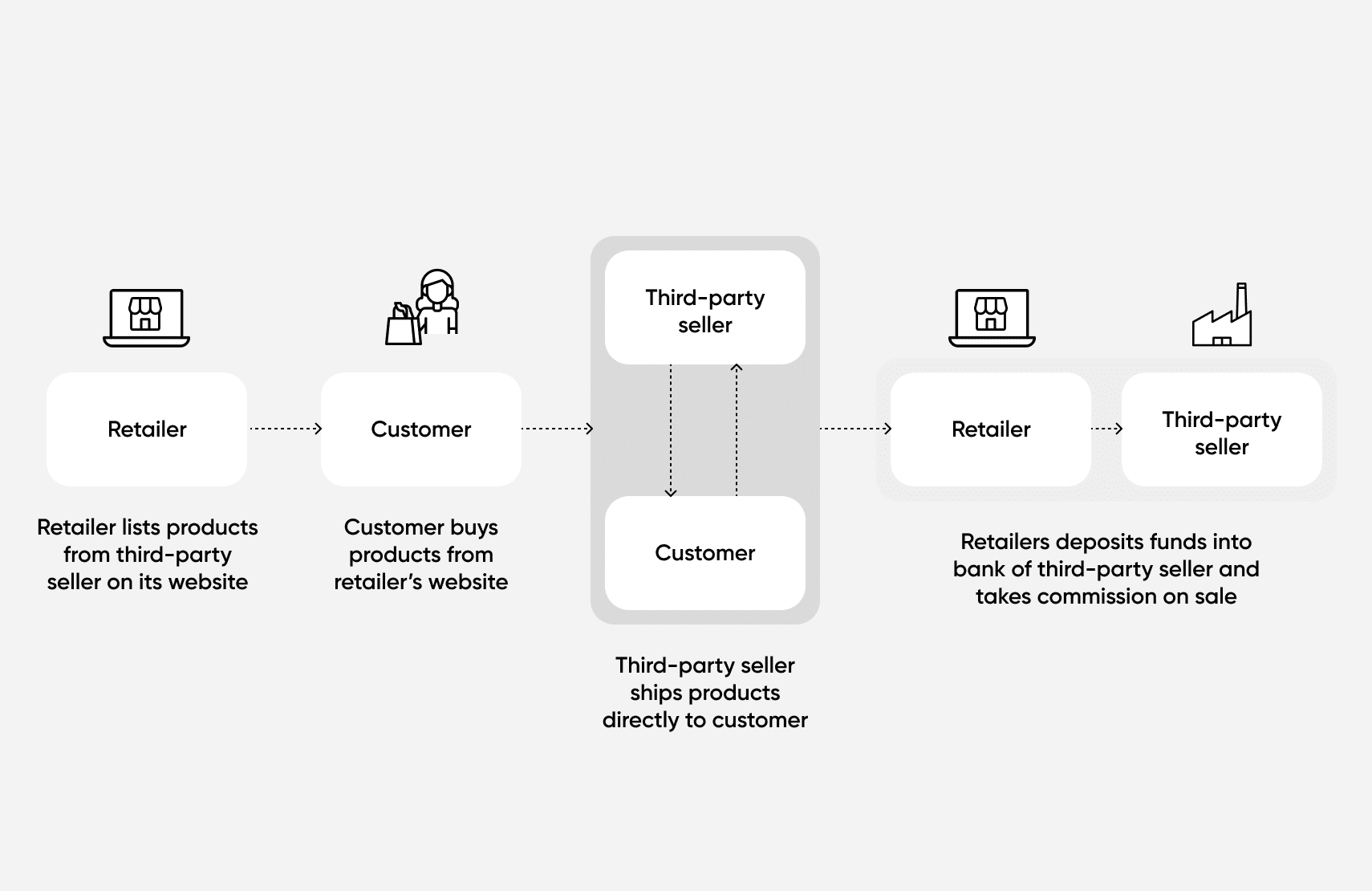The Difference Between Dropshipping and Third-Party Marketplaces

Both dropshipping and third-party marketplaces allow retailers to sell products without keeping inventory in stock, use vendors to ship products directly to customers, and free up working capital for other investments.
However, dropshipping is for companies that have a brand ethos, want full control over the customer experience, and want to build a curated product assortment.
Third-party marketplaces are for companies that want the widest product assortment and are willing to cede control over customer experience, pricing, and brand image to third-party sellers.
For brand-conscious retailers, fabric Dropship is a dropshipping solution that allows retailers to connect with vendors and sell new products and categories without taking on any inventory risk.
As the VP of Product at fabric, perhaps one of the most gratifying aspects of my job is helping our enterprise partners to design, build, and launch their dropshipping programs using fabric’s market-leading dropship solution.
In some cases, the results have been extraordinary. For example, we helped luxury bedding brand Brooklinen launch its dropshipping program, which promptly generated YOY revenue growth of 186%. Motherhood Maternity also utilized our dropshipping solution, and it generated $200k of incremental revenue within the first six months of launch. Neither company spent a single dime on additional inventory.
Of course, when you consider that gross margins can potentially reach 20% to 30% for products like electronics, or 50% to 60% for products like home goods (depending on factors like products, costs, and technology platform), it starts to become clear why many of our retail partners are excited about implementing dropship programs to expand their product assortment and generate additional revenue.
An increasingly trendy alternative for retailers is creating and hosting a third-party marketplace. This option enables retailers to scale their product assortments quickly and in a cost-effective way.
But what is the difference between the two? And is one model better than the other for growing your e-commerce business?
Similarities and differences between dropshipping and marketplace
People often confuse the terms “dropshipping” (aka “dropship marketplace” or “first-party marketplace”) and “third-party marketplace” because they bear several similarities and are often used interchangeably. For example:
- Both models allow retailers to sell products online without having to keep products in stock.
- Both models use vendors (aka “brands” or “manufacturers”) to ship products directly to customers.
- And both models allow retailers to reduce their inventory risk and free up working capital to invest in other areas.
However, that’s where the similarities end. There are clear differences between dropshipping and third-party marketplaces with the most important distinction being that with a dropshipping model, the retailer is the merchant of record and owns the full customer experience, while in a third-party marketplace model, the vendor is the merchant of record and determines many if not all points around customer experience.
In this article, we’ll explore some of the other key differences between the two, provide insights into which model is right for which type of business, and reveal the best strategy for companies that want to expand their product offering, increase revenue, and reduce their inventory risk while maintaining full control over the transactional and customer experience. If you’re ready to learn more, let’s dive in.
[toc-embed headline=”What Is Dropshipping?”]
What Is Dropshipping?
Dropshipping is simply an order fulfillment method. It allows retailers to sell products to consumers without carrying inventory. The merchant of record is the retailer but the products are shipped directly from the vendor to the consumer.
Importantly, dropshipping shifts inventory risk from the retailer to the vendor, creating an on-demand inventory model where products are only purchased and shipped when a sale is completed. It allows a retailer to quickly expand product assortment, extend product ranges, and test new offerings without the risk of traditional inventory investment.
A dropshipping program can sometimes be referred to as a dropship marketplace or a first-party marketplace.
[toc-embed headline=”How Does Dropshipping Work?”]
How Does Dropshipping Work?
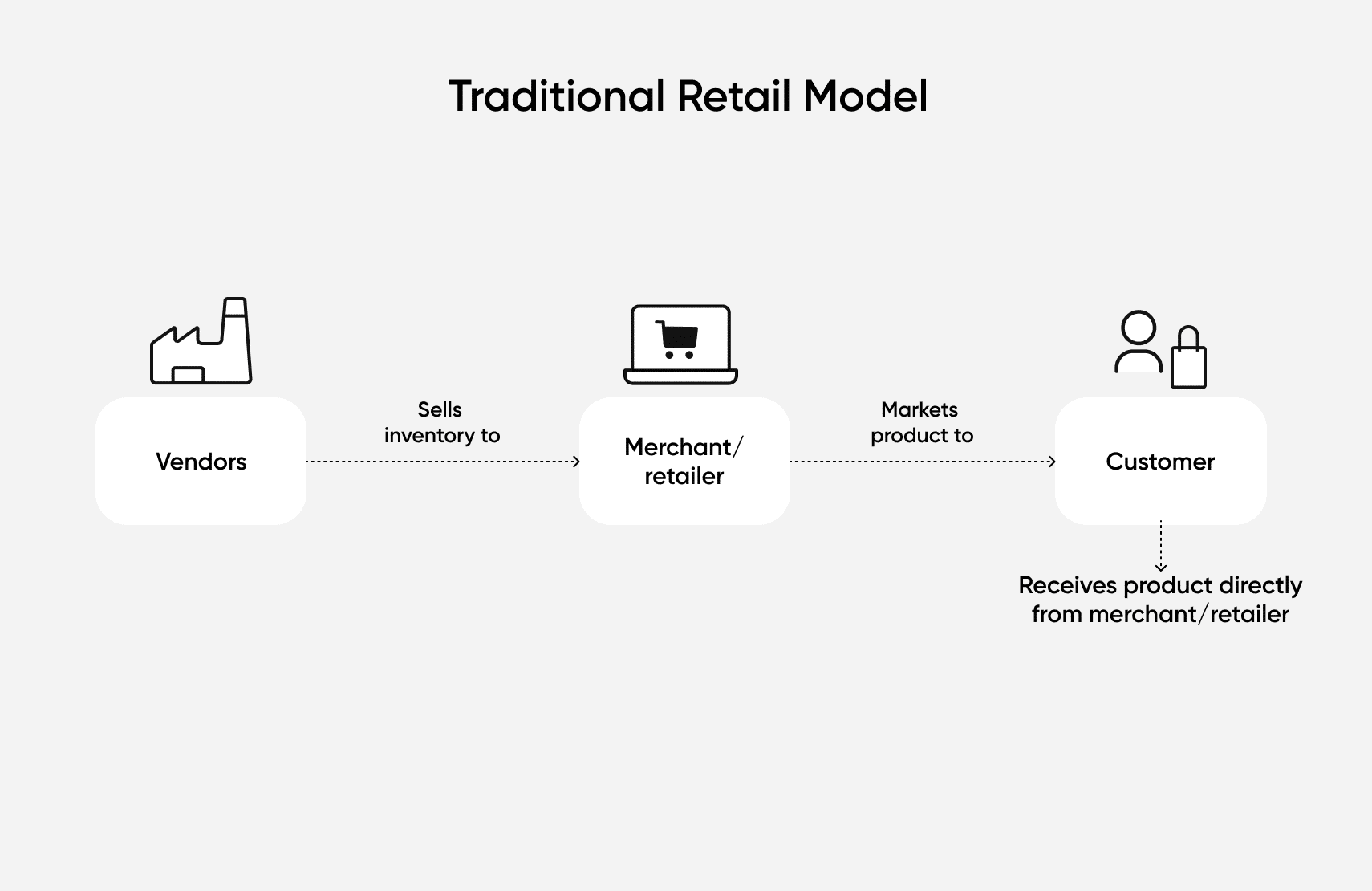
Unlike a traditional retail model, where a retailer is responsible for buying, holding, and distributing inventory, a dropship model allows a retailer to sell products on its website without purchasing or taking physical ownership of inventory. Instead, it sends the order and the shipment details to the vendor, who then ships the order directly to the customer.
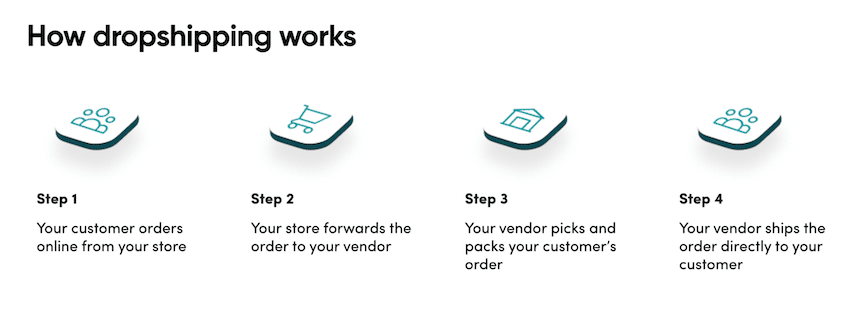
However, the retailer is still responsible for controlling the customer experience, which generally includes things like pricing, returns, promotions, and customer service. Customers don’t necessarily know (nor necessarily care) where their products ship from, as long as the fulfillment experience is quick and seamless.
Who uses dropshipping?
Dropshipping is great for companies that meet the following requirements:
- Have a brand ethos that customers trust
- Want full control over the customer experience
- Want a curated product assortment to capture additional customer spend
- Have customers searching for products they don’t carry
- Want to lower inventory risk
- Lack additional Open-to-Buy or are otherwise inventory constrained
- Want to test products and categories to learn about what their customers like
- Want to free up working capital and reduce warehousing and staffing costs
- Sell bulky items that are difficult to store and ship
- Sell non-core products that are important to have in stock
A dropship technology solution can quickly and easily connect retailers with dropshipping vendors all around the globe. Dropshipping marketplaces are software solutions built to support seamless integrations with vendors and services and automate and streamline processes and functions so businesses can accelerate time-to-market for selling new products.
What are the benefits of dropshipping?
There are additional merchandising, economic, and technological benefits to building and launching a dropshipping program.
For merchandisers and buyers who are in charge of scaling product assortment and offerings, dropshipping opens up many new opportunities. A modern dropshipping technology solution can help merchandisers to:
- Easily connect with vendors
- Gain access to new brands
- Rapidly source new products
- Utilize the latest merchandising tools to rapidly scale their inventory selection
- And reduce time-to-market for new products
There are many economic benefits from utilizing dropshipping as well. Compared with traditional owned inventory, retailers can:
- Achieve greater flexibility and higher average order value (AOV) by using the dropship fulfillment model
- Reduce operating costs for warehousing and staffing, boost margins, and improve profitability
- Free up working capital that would normally be tied up in inventory, which can then be used to fund capital expenditures
Technology benefits can also be achieved. For example, a dropshipping technology solution can:
- Automate processes for obtaining, vetting, processing, and displaying product data
- Automate and streamline manual processes for transactions (i.e. invoices and billing) and order management (i.e. tracking and fulfillment)
- Generate more online traffic through improved search engine optimization (SEO).
[toc-embed headline=”What Is A Third-Party Marketplace?”]
What Is A Third-Party Marketplace?
A third-party marketplace is an online platform that connects buyers and sellers. Retailers that adopt a marketplace model allow third-party sellers to sell products on their website.
Sellers that sell directly to the customers through a marketplace become the merchant of record. They also set the retail price and returns policy, fulfill customer orders, and handle all aspects of customer service.
[toc-embed headline=”How Does A Marketplace Work?”]
How Does A Marketplace Work?
Amazon, Etsy, eBay, and Walmart are examples of companies that host marketplaces. On these platforms, third-party sellers sell their products directly to customers and are the merchants of record. They also set the retail price and returns policy, fulfill customer orders, and handle all aspects of customer service. Amazon differs from other companies in that it offers to take on some of these responsibilities by charging additional service fees to its third-party sellers.
Retailers that host a marketplace will facilitate transactions and receive a commission on each sale completed. Generally, these commissions are a fixed fee per sale or a percentage of the retail transaction.
Similar to dropshipping, a marketplace model also eliminates inventory risk for the retailer. However, it is the seller—not the retailer—that determines the customer and transactional experience.
Who uses marketplaces?
Third-party marketplaces are great for companies that meet the following requirements:
- Rely on product reviews to build customer trust
- Want third-party sellers to take responsibility for pricing, margins, returns, promotions, and customer service
- Want the widest product assortment to capture additional customer spend
- Want to target the customer segment that shops on third-party marketplace sites
- Have customers searching for products they don’t carry
- Want to lower inventory risk
- Lack resources for merchandising and buying
- Want to free up working capital and reduce costs for warehousing and staffing
- Sell bulky items that are difficult to store and ship
- Sell non-core products that are important to have in stock
A marketplace technology solution can help companies with creating and hosting a third-party marketplace on their e-commerce website.
What are the benefits of marketplaces?
Compared with dropshipping, marketplaces generally boast a faster time-to-market to go live with new products. A retailer can rapidly enter new categories because they allow third-party sellers to take full control of the onboarding, catalog management, and customer service.
In a marketplace, sellers also compete with each other on products and pricing. When retailers shift most of their responsibilities to sellers, customers generally benefit from a wider product assortment and lower prices for the products listed.
Theoretically, there are no limits to how many products a company can offer. In retail, the rise of the internet has given online retail outlets the advantage of infinite shelf space, which means they can carry an unlimited assortment of products. The term “endless aisles” refers to the ability of retailers to offer products that are either not sold in-store or that are currently out of stock.
However, infinite shelf space does not mean that retailers should automatically sell an infinite number of products. It’s important to draw a clear distinction between “extended aisles” and “endless aisles,” as the latter can lead to too much choice for consumers. SKU proliferation and the paradox of choice are concerns that may cause anxiety for shoppers and can potentially make “endless aisles” more trouble than they’re worth for retailers.
In addition, retailers also have to be cautious about ceding control over the transactional and customer experience to third-party sellers, which can create operational and reputational risks. According to Jennifer Bartashus, a senior analyst at Bloomberg Intelligence, third-party marketplaces require a different type of expertise to ensure vendors are a good match for the retailer’s brand identity, that pricing is reasonable, and fulfillment is within customer expectations. Otherwise, customers can feel disappointed with a degraded shopping experience, which could be worse than not having a specific product.
[toc-embed headline=”Pros and Cons of Dropshipping and Marketplaces”]
Pros and Cons of Dropshipping and Marketplaces
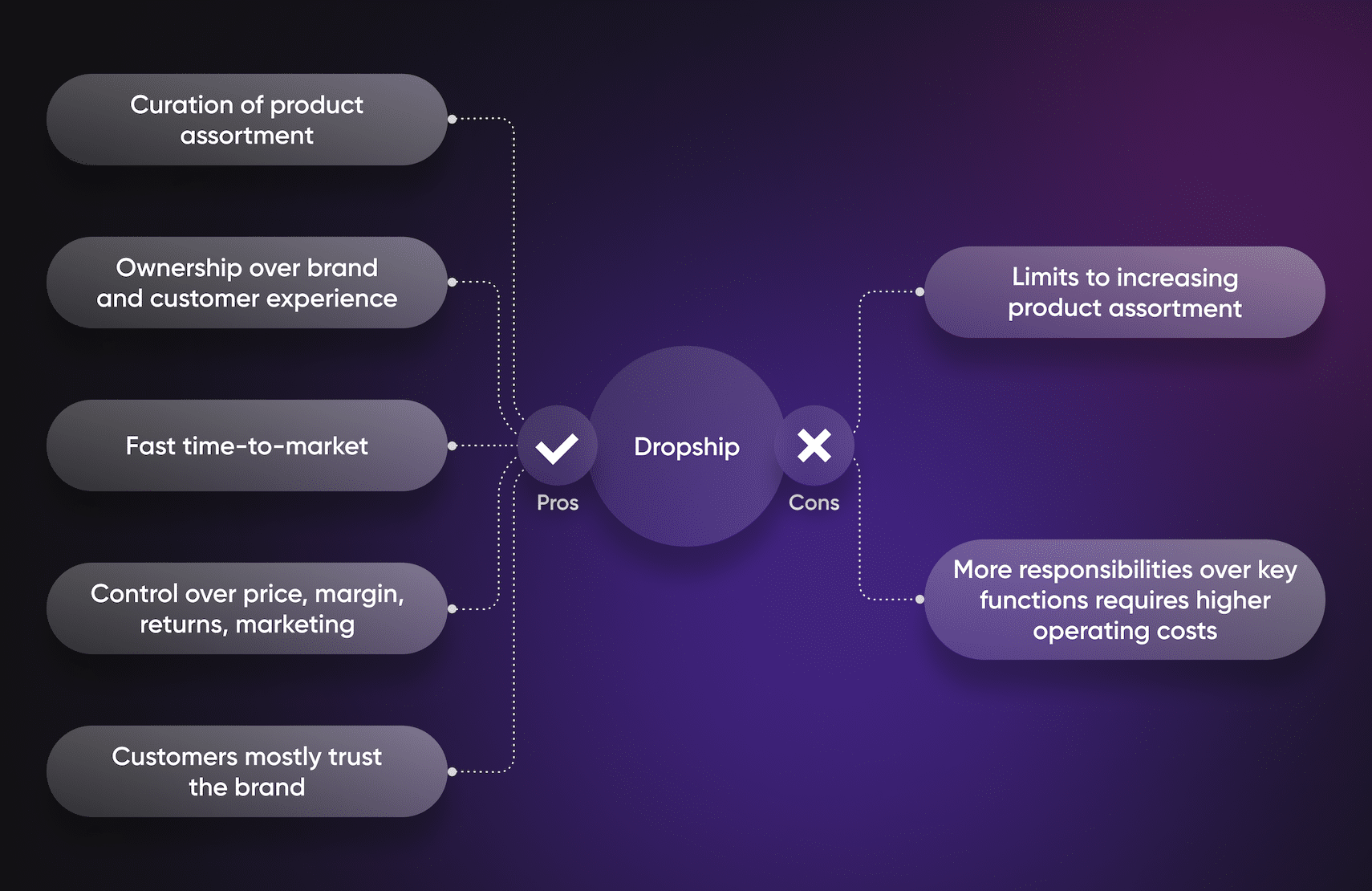
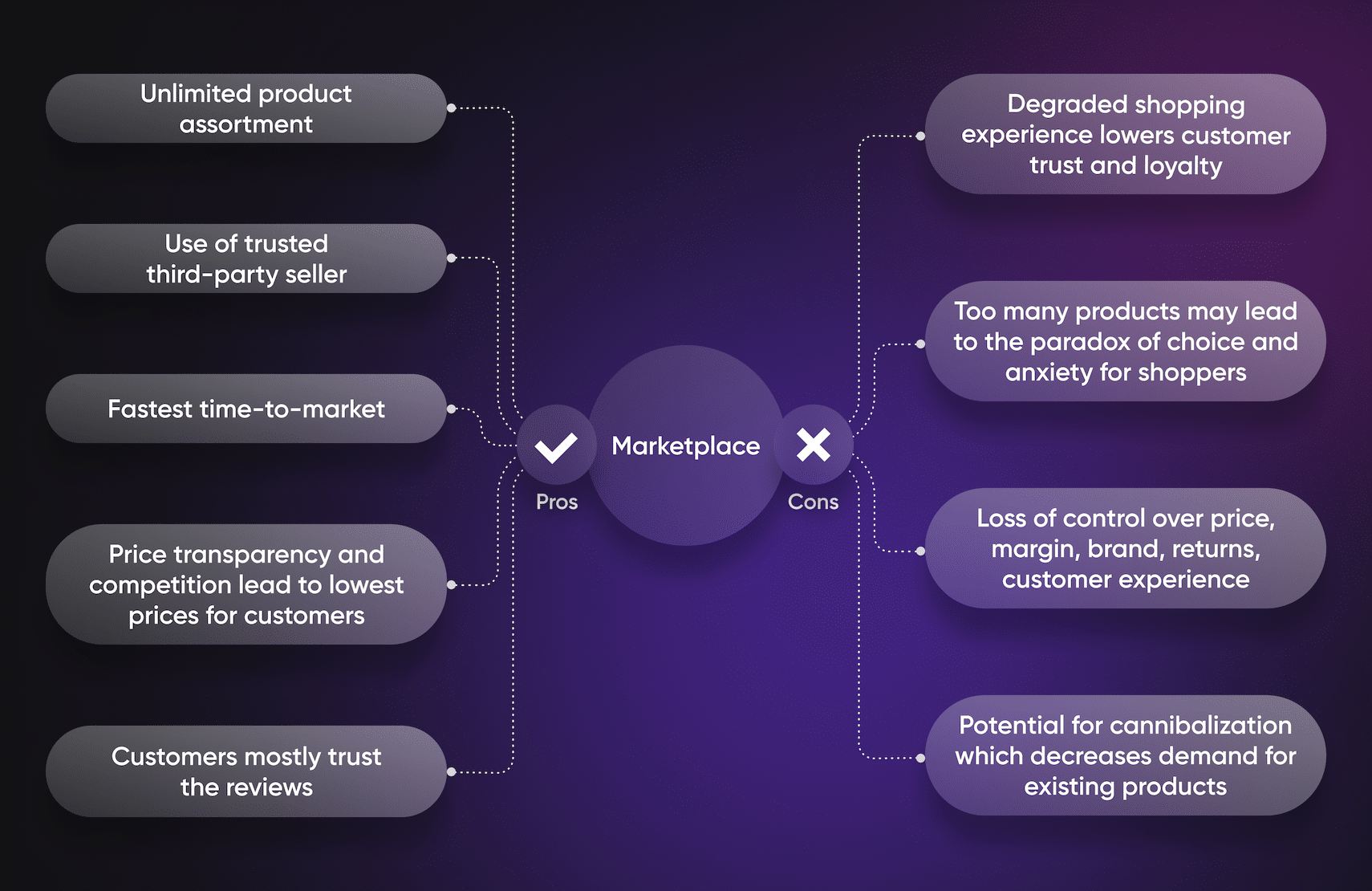
[toc-embed headline=”Dropship vs. Marketplace: Which Is Better for You?”]
Dropship vs. Marketplace: Which Is Better for You?
For retailers, dropshipping and third-party marketplaces are options that address different needs of different businesses. If a company sells a lot of commoditized products and believes that brand differentiation and customer experience will not have a meaningful impact on sales, then a third-party marketplace is likely the better choice. In some scenarios, it may be beneficial for a retailer to give up control over customer experience, pricing, and even brand image to third-party sellers—especially if their current shopping experience is sub-optimal.
However, if a company is concerned about its brand ethos and reputation, and wants to maintain full control over the customer experience, then a dropshipping program is the ideal solution for expanding product assortment and capturing more customer spend.
The right solution for you
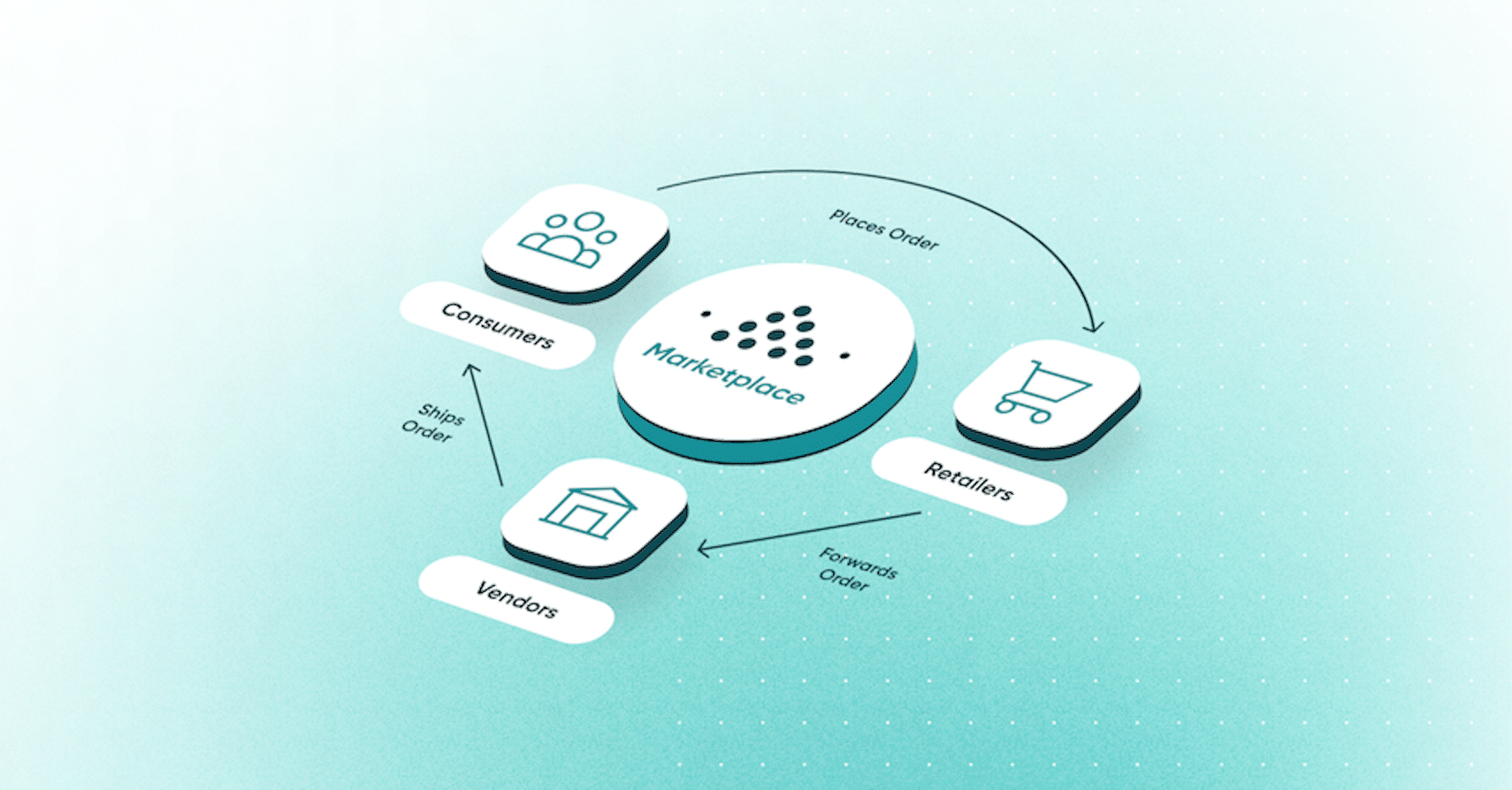
fabric Dropship is a market-leading dropship solution that allows retailers to scale their dropshipping programs easily and rapidly. From flexible onboarding and simplified merchandising to streamlined order management and smooth transaction automation, our platform provides best-in-class technologies and services that simplify and automate product information, inventory, merchandising, and transactions between merchants and vendors.
If you’d like to learn more about fabric Dropship and how it can help you expand your product assortment, generate additional revenue, and lower your inventory risk, you can request a demo with us today.

VP of Product @ fabric. Previously @ RevCascade and the Rubicon Project.
